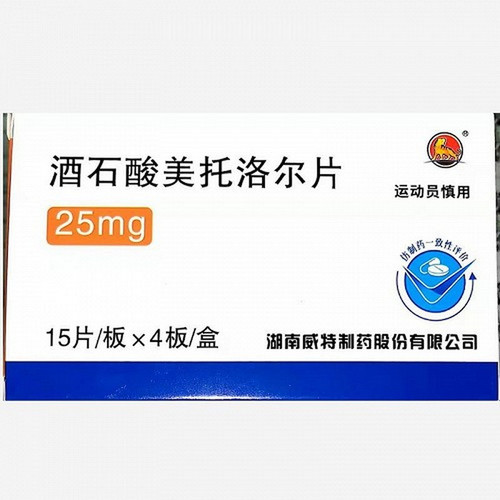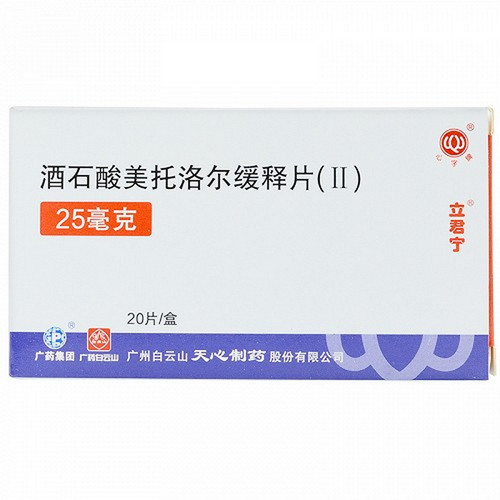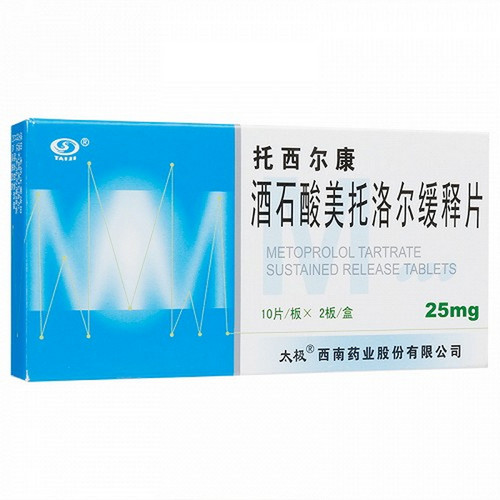Product Overview
[Drug Name]
Generic Name: Metoprolol Tartrate Tablets
Trade Name: Dawei Metoprolol Tartrate Tablets 25mg*10 Tablets*2 plates
Pinyin Code: DaWei JiuShiSuanMeiTuoLuoErPian 25mg*1OPian*2Ban
[Main Ingredients]
The main ingredient of this product is metoprolol tartrate; its chemical name is 1-isopropylamino-3-[p-(2-methoxyethyl)-2-propanol L(+)-tartrate. Molecular formula: (C₁₅H₂₅NO₃)₂.C₄H₂O₆
Molecular formula: 684.82
[Properties]
This product is a white tablet.
[Indications/Main Functions]
It is used to treat hypertension, angina pectoris, myocardial infarction, hypertrophic cardiomyopathy, aortic dissection, arrhythmia, hyperthyroidism, cardiac neurosis, etc. In recent years, it has also been used to treat heart failure.
In this case, it should be used under the guidance of an experienced physician.
[Specifications]
25mg * 10 tablets * 2 plates
[Dosage and Administration]
Oral administration. Take on an empty stomach. 1. For the treatment of hypertension, take 100-200mg once or twice daily. 2. For acute myocardial infarction: Early use, within the first few hours, is recommended. Immediate use can reduce infarct size and short-term (15-day) mortality in patients who have not undergone thrombolysis (this effect is evident 24 hours after administration). In patients who have undergone thrombolysis, it can reduce the rate of reinfarction and re-ischemia, and if administered within 2 hours, it can also reduce mortality. General Usage: Initially administer metoprolol intravenously at a dose of 2.5-5mg (over 2 minutes), followed by injection every 5 minutes for a total dose of 10-15mg three times. Fifteen minutes later, begin taking 25-50 mg orally every 6-12 hours for 24-48 hours, followed by 50-100 mg twice daily. 3. Unstable angina: Early use is also recommended. The dosage and administration should refer to those for acute myocardial infarction. 4. In the case of atrial fibrillation in acute myocardial infarction, if there are no contraindications, intravenous metoprolol can be used, using the same method as above. 5. After myocardial infarction, long-term use is recommended, if there are no contraindications, as it has been shown to reduce cardiac mortality, including sudden death. The general dosage is 50-100 mg twice daily. 6. For the treatment of angina, arrhythmias, hypertrophic cardiomyopathy, and hyperthyroidism, the general dosage is 25-50 mg two to three times daily, or 100 mg twice daily. 7. Heart failure: This medication should be used in addition to anti-heart failure treatments such as digitalis and/or diuretics. Initially, the dose should be 6.25 mg twice daily. Subsequently, depending on clinical condition, the dose may be increased by 6.25-12.5 mg every few days to once a week, two to three times daily, to a maximum dose of 50-100 mg twice daily. 8. The maximum daily dose should not exceed 300-400 mg.
[Adverse Reactions]
1. Cardiovascular System: Decreased heart rate, conduction block, decreased blood pressure, worsening heart failure, peripheral vasospasm leading to cold extremities or loss of pulse, and Raynaud's phenomenon. 2. Due to its lipid solubility and easy penetration into the central nervous system, this system has more adverse reactions. Fatigue and dizziness account for 10%, depression for 5%, and other adverse reactions include headache, frequent dreams, and insomnia. Hallucinations may occur occasionally. 3. Digestive System: Nausea, stomach pain, and constipation occur in <1%, and diarrhea occurs in 5%, but these are not serious and rarely affect medication use. 4. Other: Shortness of breath, joint pain, itching, retroperitoneal fibrosis, deafness, and eye pain. Contraindications: Hypotension, significant bradycardia (heart rate <45 beats/minute), cardiogenic shock, severe or acute heart failure, moderate to severe atrioventricular block, or sick sinus syndrome. Metoprolol should not be used in patients with suspected acute myocardial infarction, as manifested by a heart rate <45 beats/minute, a P-Q interval >0.24 seconds, or a systolic blood pressure <100 mmHg. This product is contraindicated in patients with hypersensitivity to any of the ingredients.
Drug Interactions: Patients concurrently taking sympathetic ganglion blockers, other beta-blockers (e.g., current-limiting agents), or monoamine oxidase (MAO) inhibitors must be closely monitored. If discontinuation of co-administration with clonidine is planned, beta-blockers should be withdrawn several days prior to clonidine withdrawal. Concomitant use of metoprolol with verapamil and dihydropyridine calcium channel blockers may increase negative inotropic and chronotropic effects. Verapamil-type calcium channel blockers should not be administered intravenously in patients taking beta-blockers. Beta-blockers may increase the negative inotropic and chronotropic effects of antiarrhythmic drugs (quinidine and amiodarone). Inhalational anesthesia may increase the cardiodepressant effect in patients receiving beta-blockers. Enzyme-inducing and enzyme-inhibiting substances may affect metoprolol plasma levels. Rifampin may decrease metoprolol plasma concentrations. Cimetidine, ethanol, hydralazine, and selective serotonin reuptake inhibitors (SSRIs) such as paroxetine, fluoxetine, and sertraline can increase metoprolol blood levels. Preemptive use of nicotine may also increase metoprolol blood levels. Concomitant use with indomethacin or other prostaglandin synthase inhibitors can reduce the antihypertensive effect of beta-blockers. In some cases, patients taking beta-blockers may benefit from the use of epinephrine. Cardioselective beta-blockers have a much smaller effect on blood pressure control than non-selective beta-blockers. For patients receiving beta-blockers, the dose of their oral hypoglycemic medications must be adjusted.
[Precautions]
1. Propranolol can delay the recovery of blood glucose levels after insulin administration, but this adverse effect is less pronounced with selective beta-blockers. It is important to note that when beta-blockers are added to diabetic patients taking insulin, the beta-blocking effect can mask symptoms of hypoglycemia, such as palpitations, thereby delaying the timely detection of hypoglycemia. However, the risk of selective beta-1 blockers interfering with glucose metabolism or masking hypoglycemia during treatment is lower than that of non-selective beta-blockers. 2. If treatment is interrupted during long-term use of this drug, the dose must be gradually reduced, generally within 7-10 days, with at least 3 days to wait. Abrupt discontinuation of this drug, especially in patients with coronary artery disease, can worsen the condition, leading to angina, myocardial infarction, or ventricular tachycardia. 3. Opinion remains divided on whether to discontinue beta-blockers before major surgery. Beta-blockade reduces the heart's response to reflex sympathetic stimulation, increasing the risks of general anesthesia and surgery, but this can be reversed with dobutamine or isoproterenol. Nevertheless, it is best to discontinue this drug in patients undergoing general anesthesia, if possible 48 hours before anesthesia. 4. When used for pheochromocytoma, an alpha-blocker should be used first. 5. Use with caution in patients with hypotension or cardiac or hepatic insufficiency. 6. Metoprolol should be used with caution in patients with chronic obstructive pulmonary disease and bronchial asthma. If necessary, a low dose is recommended, generally less than that of atenolol of equal potency. Patients with bronchial asthma should also receive a β2-receptor agonist, and the dose can be adjusted based on the metoprolol dose. 7. For patients with impaired cardiac function and metabolism, metoprolol should be used in addition to digitalis or diuretic therapy. For specific instructions, see (Dosage and Administration). (See package insert for details.)
[Pediatric Use]
Experience with this product in children is limited.
[Elderly Use]
The pharmacokinetics of metoprolol in the elderly are not significantly altered compared to younger patients, so no dosage adjustment is required for elderly patients.
[Overdose]
Symptoms: Metoprolol overdose can result in severe hypotension, sinus bradycardia, atrioventricular block, heart failure, cardiogenic shock, cardiac arrest, bronchospasm, impaired consciousness/coma, nausea, and vomiting.
(See package insert for details.) [Pharmacology and Toxicology] This drug belongs to Class 2A, meaning it is a β1-receptor blocker without partial agonist activity (cardioselective β1-receptor blocker). It selectively blocks β1-receptors, lacks PAA (partial agonist activity), and has no membrane stabilizing effect. Its β1-receptor blocking effect is approximately equivalent to that of propranolol (PP), but its selectivity for β1-receptors is slightly lower than that of atenolol. Metoprolol's cardiac effects, such as slowing heart rate, inhibiting cardiac contractility, reducing automaticity, and delaying atrioventricular conduction time, are similar to those of propranolol and atenolol (AT). Its effect on reducing elevated blood pressure and heart rate during exercise testing is also similar to that of PP and AT. Its contractile effect on vascular and bronchial smooth muscle is weaker than that of PP, resulting in less respiratory effects, but still more potent than that of AT. Metoprolol also reduces plasma renin activity.








